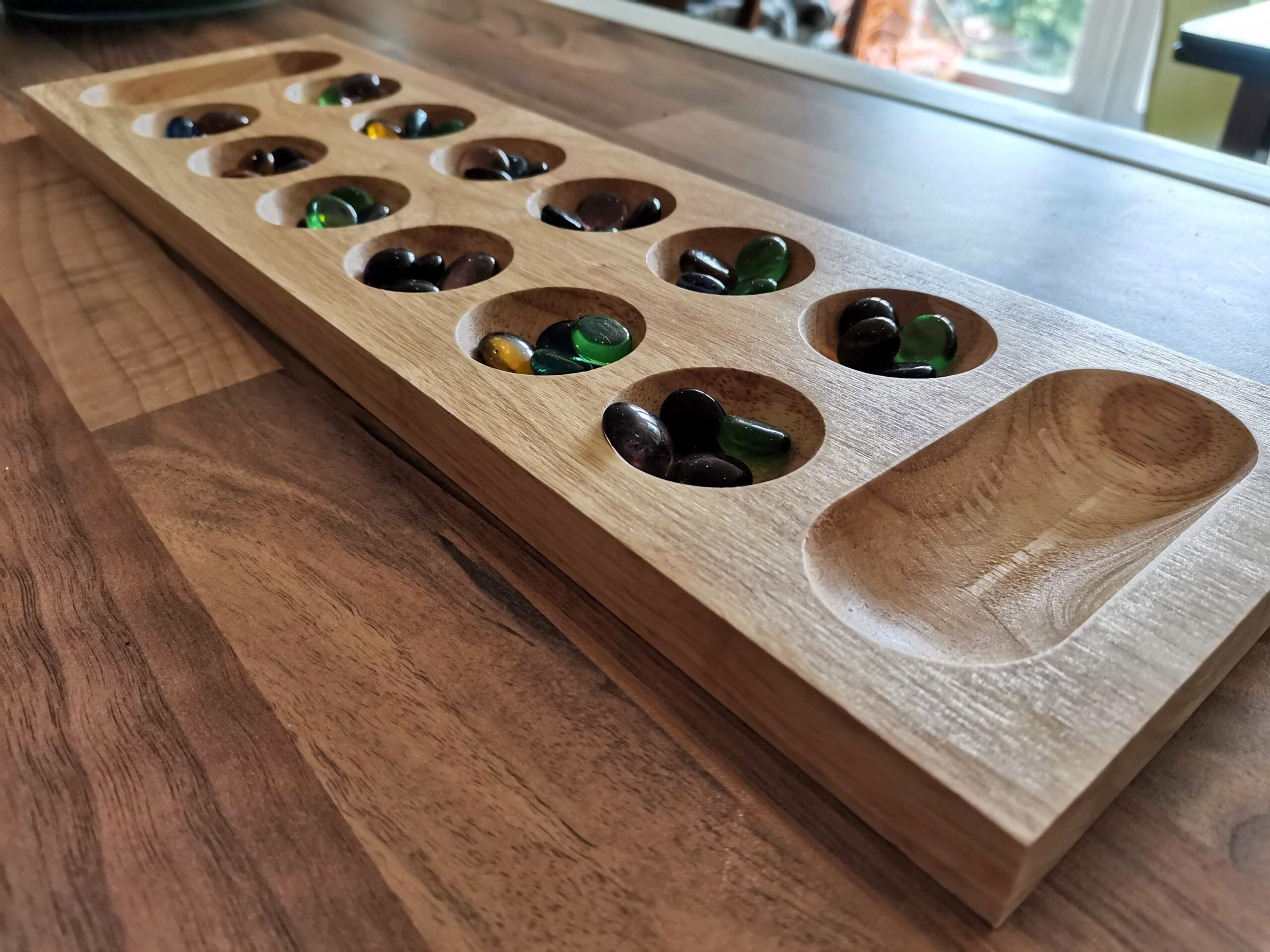PARKS Review
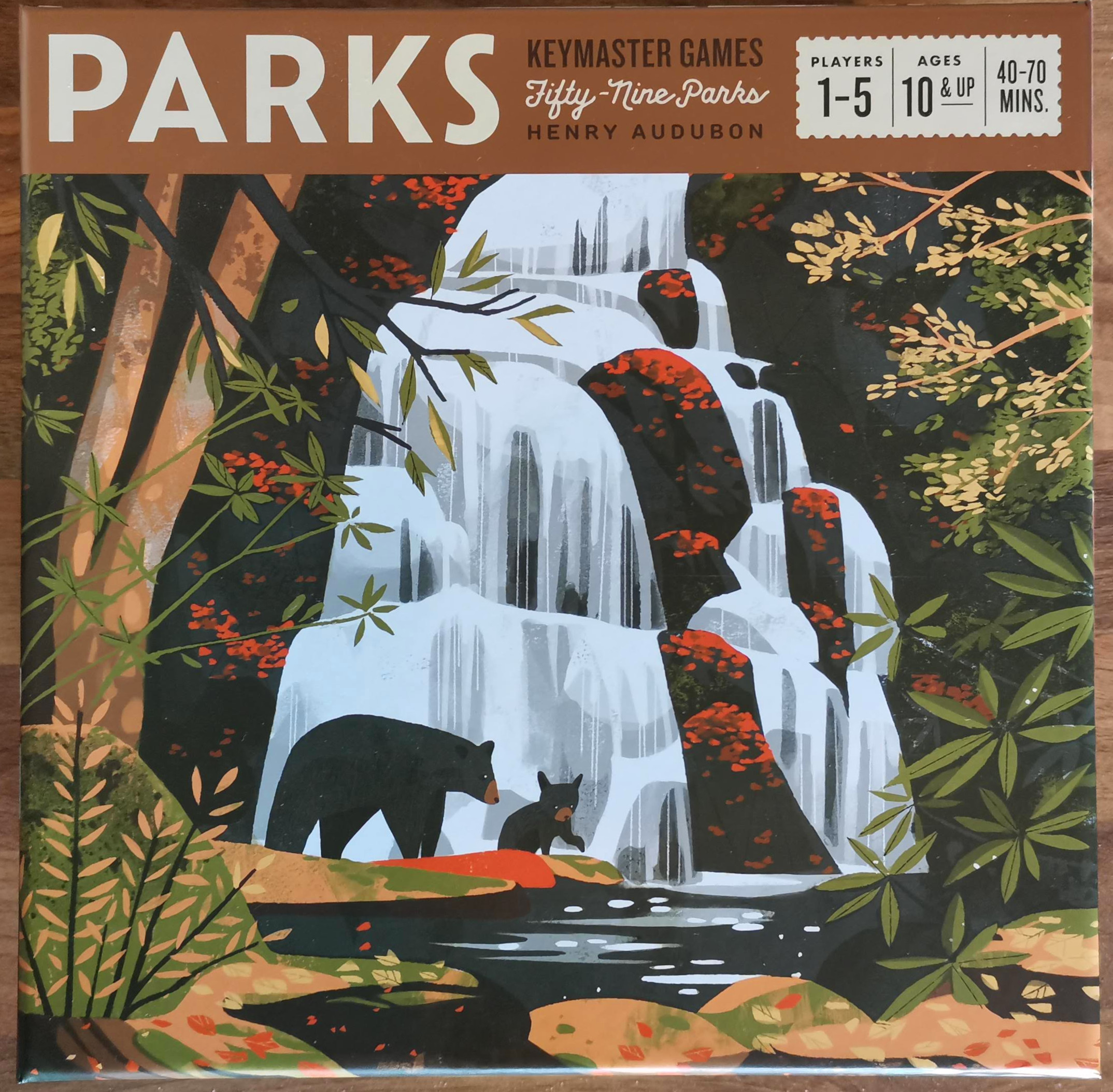
Update
Since writing this review, I’ve made a video review too. If you’d like to take a look, here you go. Otherwise, read on for the original.
Have you ever wanted to wander the trails around America’s National Parks? Take some photographs, enjoy the weather, and take in the sights? If, like me, that’s a fantasy for you, there is an alternative – the PARKS board game, by Keymaster Games.
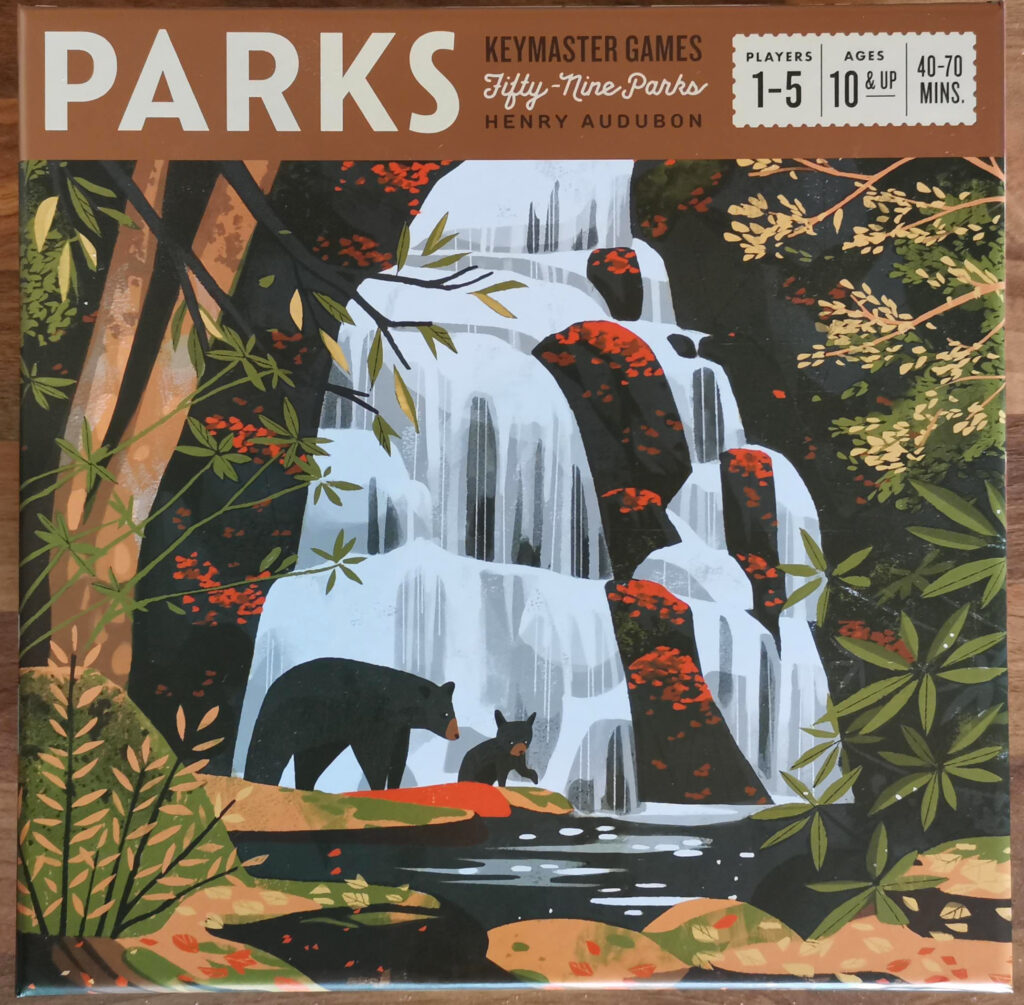
PARKS (the capitilisation is theirs, not mine) is a collaboration between Keymaster Games and the Fifty-Nine Parks Prints Series. It’s a lightweight game of sightseeing and trekking for one to five players, which sees players taking two hikers through four seasons of touring the National Parks.
What’s In The Box
I always add this section in a review, and usually it’s just to highlight what variety of pieces you can expect to find in the box. In the case of PARKS though, the box and the contents have had so much love and attention lavished on them, it really needs to be highlighted.
First off, the box and insert is perfect. Every single piece has a place in the box, and a mechanism for getting them out easily. Some pieces have specially formed spaces under other pieces, and the side of the box has a diagram explaining how to put everything back the first time you play it. It’s to be expected I suppose, Keymaster brought in Gametrayz to do the work, and they’ve done an incredible job. Even the resource holders look like tree branches, and it all makes setup and tear-down a pleasurable job.
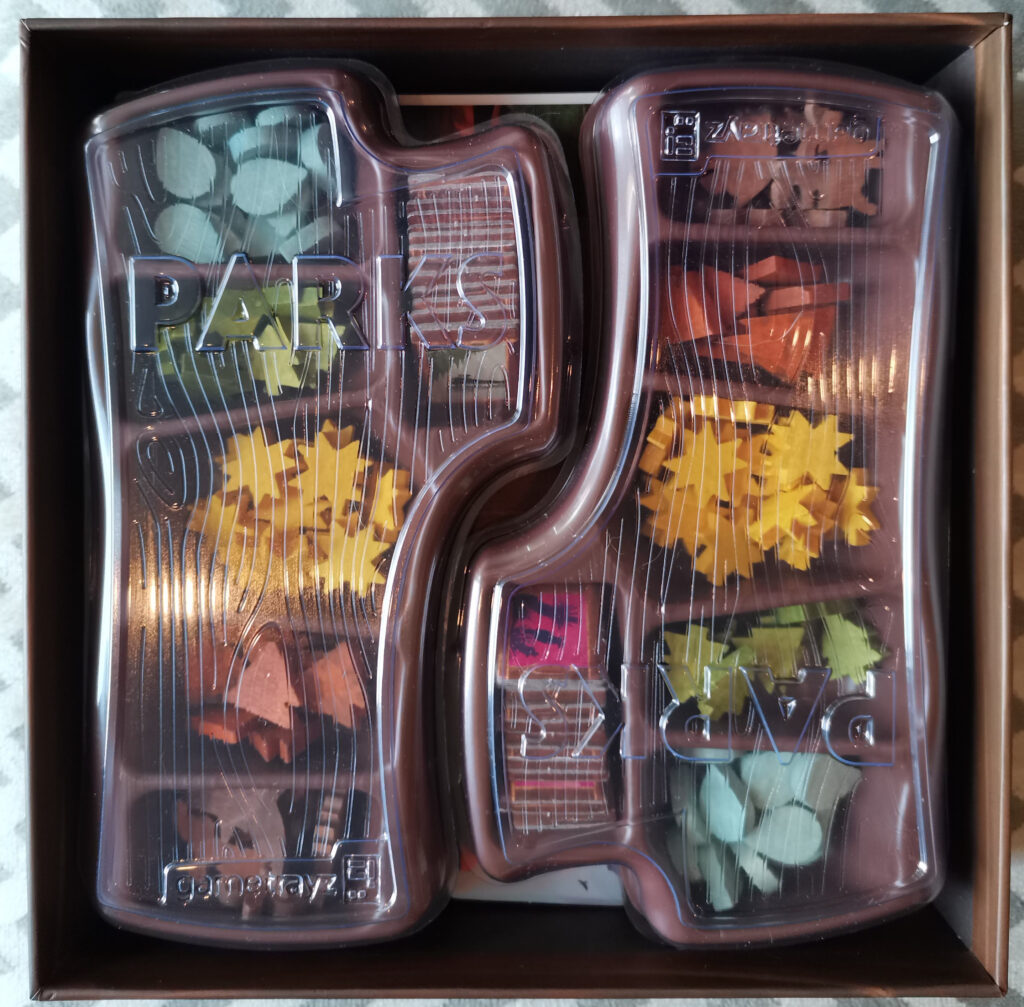
The cardstock for the pieces is solid and will last, the meeples have hiker figures screenprinted on them, and the resources are all little custom wooden pieces. Raindrops, sunshine, pine trees, mountains and my personal favourite – the wildlife. The wildlife pieces act as wild (get it?!) resources, but rather than take a shortcut and make loads of the same piece, every individual piece of wildlife is unique, and something that can be found in the real National Parks.
There’s a gorgeous enamel pin badge which serves as the first player marker, and the cards are the star of the show. A really nice linen finish, and while most of the cards are half-size pieces with nice graphic design and iconography, the cards that represent the parks themselves are oversized and have beautiful, individual artwork. The artists, who vary from card to card, all have credit in the manual, and there’s a lot of this art I’d like to have hanging on my walls.
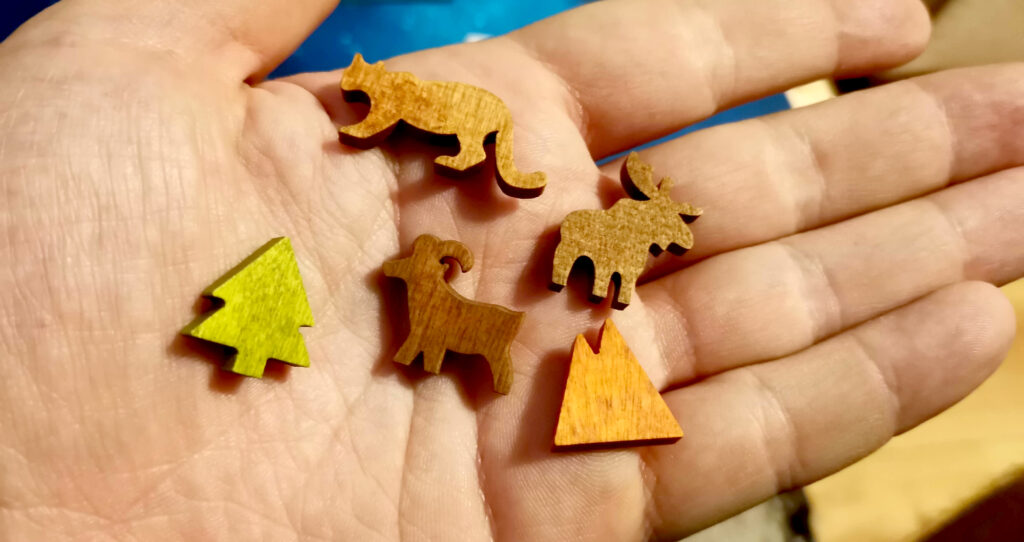
How Does It Play?
I’ve talked a lot about the production, but this site is where I write reviews of games, so let’s have a look at the game.
The premise of PARKS is the players taking on the role of hikers. For each of the four seasons, trail tiles are mixed up and laid down, and players take it in turn to visit them, collecting resources along the way to spend on visits to parks and buy new gear to make the trip easier. Each season the trail gets a little longer, and players vie to complete their own secret objectives
Setup & Basics
The main board sits at the top of the table and has spaces for several decks. The Parks deck is placed and the first three revealed, and the Canteen, Gear and Season decks are placed. Beneath that, the trail start and trail end tiles are placed with a gap between them. The basic trail tiles are shuffled along with one of the extra tiles, and they’re laid down between the start and end tiles in random order to create the trail. These trail tiles have a nice chevron design which lets them fit together like a jigsaw. It’s very pleasing aesthetically.

Each player draws two year goal cards, keeps one, and discards one, in secret. These give the players a hidden extra objective, which if they are successful with, can grant them either two or three extra points at the end of the game. That might not sound like much, but when the 20-30 point range is a decent score, any extra points are like gold dust. The plays each then draw a canteen card, which act as personal bonuses, and usually mean when some gains water from a trail spot, they can trade it in for something different. Finally, the season card is turned which gives a pattern to lay bonus resources on the trail with, and a bonus for the coming season when certain conditions are met. Each player places their two hikers at the start of the trail, someone takes the first player badge, and you’re ready to play.
Gameplay
To play the game is deceptively simple. You take either of your hikers and move them to a spot further along the trail than where they are now. The number of spaces is entirely up to you, you can get straight to the end of the trail if you like. The problem is that you can only ever move forwards. If you skip a spot on the trail, you can never go back to it. If you want to land on a tile occupied by another hiker, you can extinguish your campfire by flipping your campfire tile over – but only once per season.

When you land on a trail spot, you carry out the action on it. Most allow you to take resource tokens, plus any bonus tokens if you’re the first visitor. Some let you trade resources for another type, and one lets you either take a photo by spending two resources (one if you currently have the camera) or take another canteen card. There’s also an extra tile which gets added in by the end of the game, and a spot at the end of the trail, which allow you to either reserve or buy a Park card.
Other than photographs, which are worth one point each at the end of the game, the way you score victory points in PARKS is by collecting the Parks cards. Each one you collect represents a park you visited, and is worth a number of victory points. To claim one, once you land on the required spot you can pay the resources shown on the card (less any bonuses you might have from Gear cards) and add them to your play area. You can claim either one of the three on the main board, or one that you’ve previously reserved and have turned horizontally in front of you.
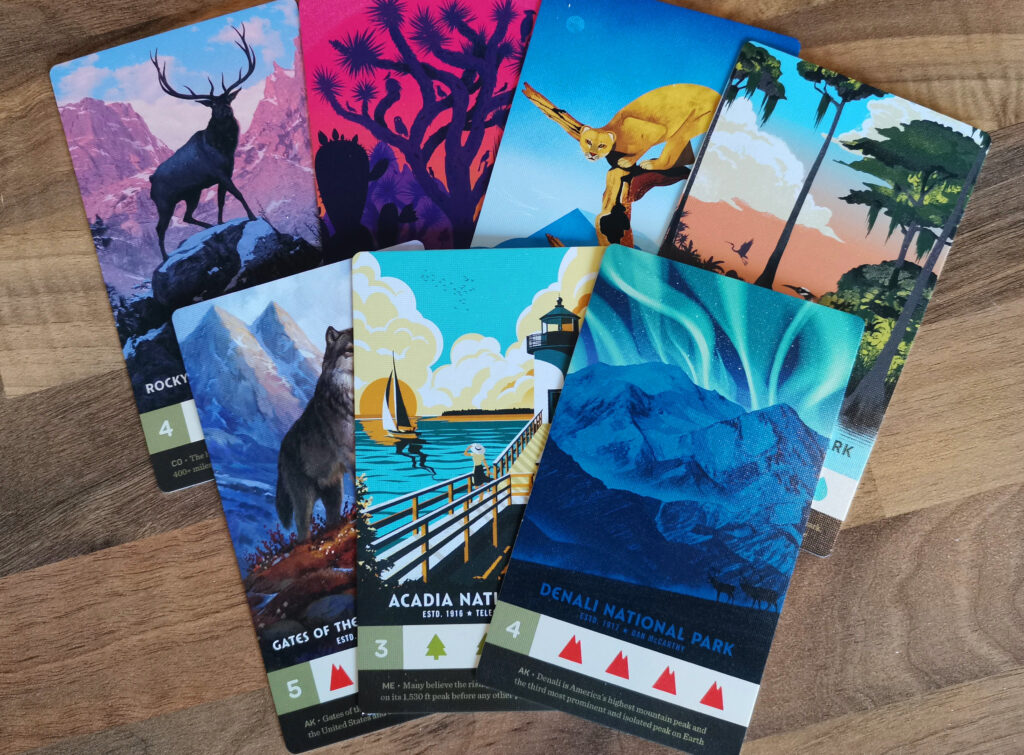
The first hikers to arrive at the trail end are able to claim a spot which might give them another reserved park, the first player marker, or buy some gear. This once all the hikers have finished the trail, the game is set-up for the next season in the same way as the start of the game, but with one extra trail tile shuffled in. This way every trail is different in terms of which resources are where, and each season is a little longer than the previous one. At the end of the fourth season the points on the Parks cards are tallied along with the photographs, any bonus points from each players’ secret year card, and the player who finished with the first player badge gets an additional point. The player with the most points is the winner.
That’s all there is to it really, as I mentioned above, it’s not a complicated game, but the play can be quite tactical. Timing is everything.
Final Thoughts
The problem with PARKS, if you want to call it a problem, is that everyone focuses on how pretty it is. I did exactly the same at the start of the review, so I’m just as guilty of that. They say beauty is skin deep, and my worry going into my first play of the game was that there’d be very little game once you wipe the make-up off. I’m very happy to say that my fears were unfounded.
PARKS is a tight, tactical little game, and in some ways I’d say it’s like a microcosm of Maracaibo. No, wait, hear me out. The gameplay loop of trying to suss out your opponents intentions, and deciding whether to race ahead to claim resources, or bide your time and visit more spaces, it’s similar in both. I get the same feeling of tension in both.
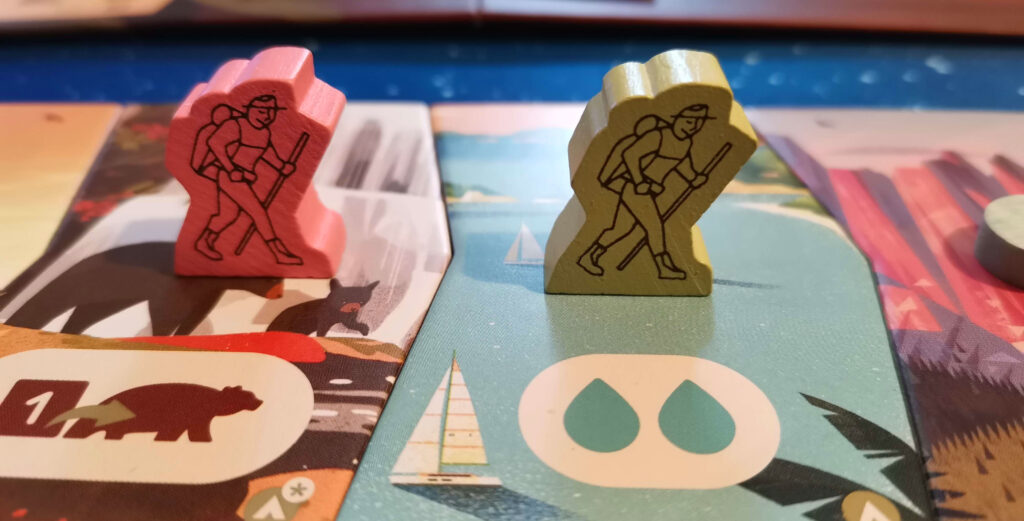
By the time you’re into the third or fourth season there’s a lot of information you need to keep in mind at any one time. You have your own canteens and gear cards to bear in mind, as well as what everyone else has in front of them. You can see everyone’s collected parks and photographs so know exactly how many points they’re going to end up with, so then there’s this meta game of looking at the things they’re collecting, trying to guess what their year-end bonus card is, and then denying them of the opportunity to add to it.
I’ve had games where the top three places are decided by a spread of four points, and it’s times like that when you realise that even just having the first player badge at the end of the game for an extra point can be absolutely critical. It feels more relaxed with two players, but for each player you add to the game, the game length seems to increase exponentially. If you’ve got a player who gets analysis paralysis, you might need a house rule of a time limit per turn, or you could be there all night while they do the maths.
Introductions
Good Gateway games are a bit of a Holy Grail for some people. Those games that are friendly enough to teach to people who don’t play games, but dangle excitement in front of them like a glittery carrot for those who find themselves drawn to it. PARKS is now in my collection of Gateway games for exactly this reason. I can teach this to someone just on the promise of a leisurely stroll through some pretty artwork, collecting cards along the way. But I know that for the vast majority of people there will be that moment of ‘”Wait, so if I get these things, I can get that other thing and get more points?”, and that’s when they’re hooked. The mechanics are so simple, but the scope for tactical play is great, and means die-hard euro fans like me can still enjoy a reasonably meaty game.
PARKS has a lot of hype at the moment, and stock is low in many places, so while it is a great game, with amazing components, I would say don’t pay over the odds for it. If you’re a regular gamer with a decent collection, there’s not much new here. However, it’s an astonishingly well-produced game which can sit proudly on your shelves with the likes of Everdell or any Ian O-Toole games when it comes to artwork.
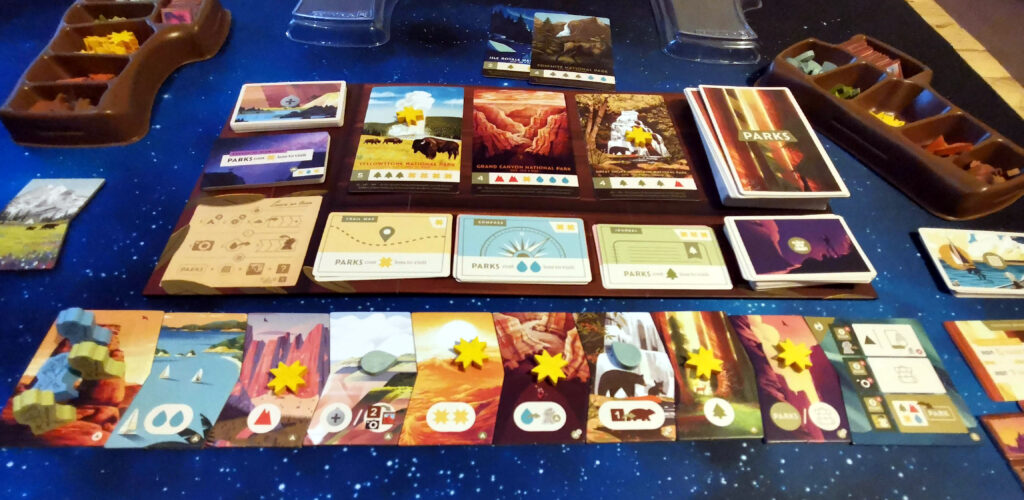
If you’ve got people who like to play lighter games, I’d say this is probably an automatic purchase. It’s also got a solid little beat-your-own-score solo mode, with an AI opponent which does a pretty good job of imitating a real player, but they just block spots and cards instead of gathering their own points. More than once I’ve taken the game out at the end of a stressful day of work to just wind down with the solo mode though, it’s just such a nice game to play.
PARKS is a beautiful, friendly game, which fills me with gladness just to put on the table. If there’s a space in your collection for a lighter game which strays away from sci-fi and dungeons, I’d recommend PARKS in a heartbeat.







